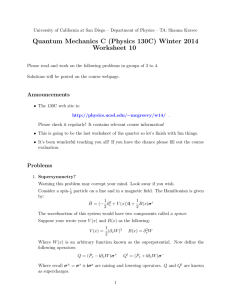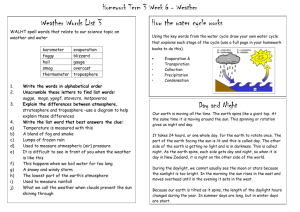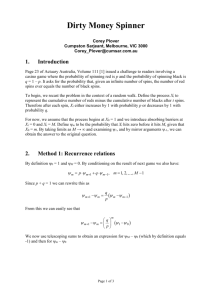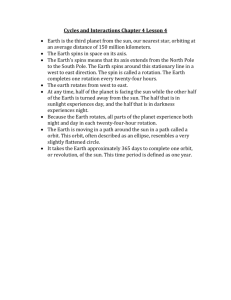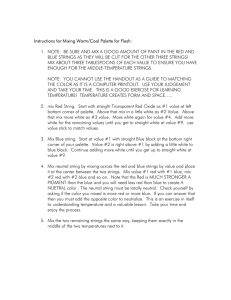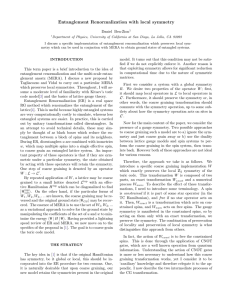Emergence of Gauge Symmetry in a Lattice Spin System Minyoung You
advertisement
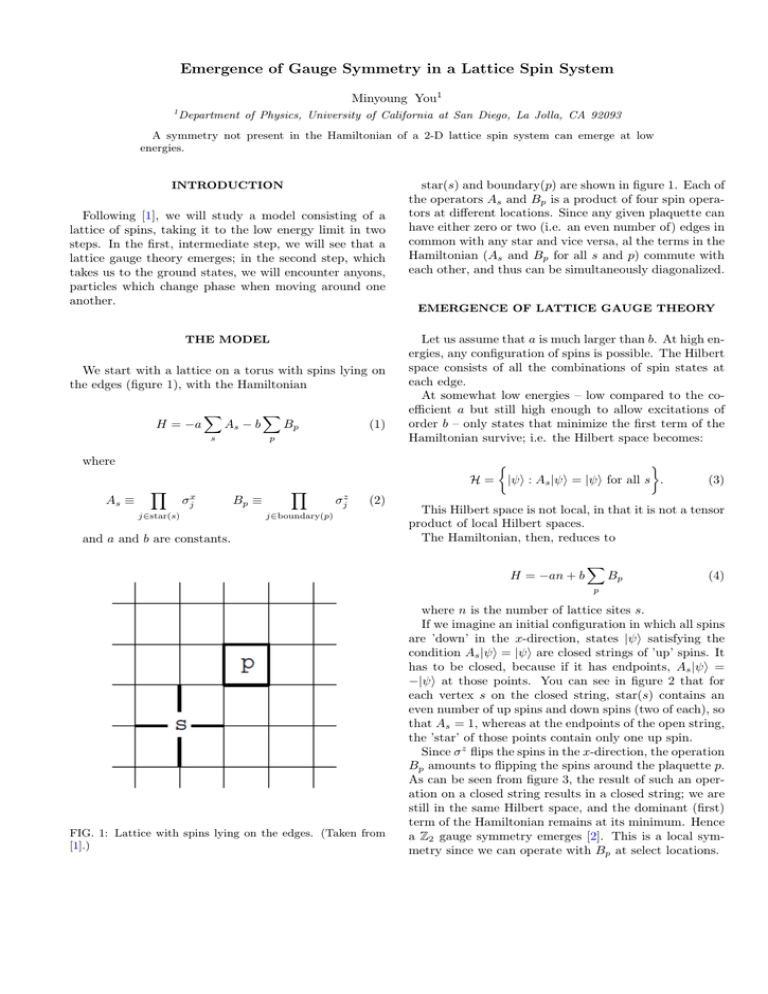
Emergence of Gauge Symmetry in a Lattice Spin System
Minyoung You1
1
Department of Physics, University of California at San Diego, La Jolla, CA 92093
A symmetry not present in the Hamiltonian of a 2-D lattice spin system can emerge at low
energies.
INTRODUCTION
Following [1], we will study a model consisting of a
lattice of spins, taking it to the low energy limit in two
steps. In the first, intermediate step, we will see that a
lattice gauge theory emerges; in the second step, which
takes us to the ground states, we will encounter anyons,
particles which change phase when moving around one
another.
THE MODEL
We start with a lattice on a torus with spins lying on
the edges (figure 1), with the Hamiltonian
H = −a
X
As − b
s
X
Bp
(1)
p
star(s) and boundary(p) are shown in figure 1. Each of
the operators As and Bp is a product of four spin operators at different locations. Since any given plaquette can
have either zero or two (i.e. an even number of) edges in
common with any star and vice versa, al the terms in the
Hamiltonian (As and Bp for all s and p) commute with
each other, and thus can be simultaneously diagonalized.
EMERGENCE OF LATTICE GAUGE THEORY
Let us assume that a is much larger than b. At high energies, any configuration of spins is possible. The Hilbert
space consists of all the combinations of spin states at
each edge.
At somewhat low energies – low compared to the coefficient a but still high enough to allow excitations of
order b – only states that minimize the first term of the
Hamiltonian survive; i.e. the Hilbert space becomes:
where
H=
As ≡
Y
σjx
j∈star(s)
Bp ≡
Y
σjz
(2)
j∈boundary(p)
and a and b are constants.
|ψi : As |ψi = |ψi for all s .
(3)
This Hilbert space is not local, in that it is not a tensor
product of local Hilbert spaces.
The Hamiltonian, then, reduces to
H = −an + b
X
Bp
(4)
p
FIG. 1: Lattice with spins lying on the edges. (Taken from
[1].)
where n is the number of lattice sites s.
If we imagine an initial configuration in which all spins
are ’down’ in the x-direction, states |ψi satisfying the
condition As |ψi = |ψi are closed strings of ’up’ spins. It
has to be closed, because if it has endpoints, As |ψi =
−|ψi at those points. You can see in figure 2 that for
each vertex s on the closed string, star(s) contains an
even number of up spins and down spins (two of each), so
that As = 1, whereas at the endpoints of the open string,
the ’star’ of those points contain only one up spin.
Since σ z flips the spins in the x-direction, the operation
Bp amounts to flipping the spins around the plaquette p.
As can be seen from figure 3, the result of such an operation on a closed string results in a closed string; we are
still in the same Hilbert space, and the dominant (first)
term of the Hamiltonian remains at its minimum. Hence
a Z2 gauge symmetry emerges [2]. This is a local symmetry since we can operate with Bp at select locations.
2
FIG. 4: Closed loops around the torus. (Taken from [3].)
FIG. 2: An open string (upper left) and a closed string (right).
Bold lines are ’up’ spins.
H=
|ξi : As |ξi = |ξi,
Bp |ξi = |ξi for all s and p
(7)
FIG. 3: Operating with Bp leaves the energy unchanged.
(Taken from [1].)
Since σ z flips the spins in the x-direction, satisfying
Bp |ψi = |ψi means the state |ψi has to be invariant
under flipping. Hence the ground states are uniform superposition of closed strings: the flipping operation will
deform some strings into other strings, but since the coefficients of each string is the same the operation will result
in the same state. Schematically,
ABSENCE OF MAGNETIZATION
This system can have no magnetization. We can see
this in the following way [2]:
|ψi = √
z
−1
z
hψ|σjz |ψi = hψ|As A−1
s σj As As |ψi = hψ| − σj |ψi
(5)
1 X
|Ci
NC {C}
(8)
for j ∈ star(s), since As |ψi = |ψi (we have used the
facts that σ x and σ z anti-commute and σ x is its own
inverse). Hence
(6)
where {C} runs over spin configurations which consist
of collections of close strings.
As we go to even lower energies, states not satisfying
the second constraint, Bp |ψi = |ψi also get thrown away,
and only the true ground states remain. The Hilbert
space further reduces to:
Since we are on the torus, there can be four kinds of
distinct closed loops: there are two ways in which the
strings can wrap around the torus (see figure 4), and the
number of up spins (in the z-direction) along those loops
can be even or odd (whether it is even or odd is conserved
with respect to the operations As and Bp ). Hence there
is a four-fold degeneracy for the ground state.
hσ z i = 0.
THE GROUND STATES
3
cle around a z-type particle along a loop c (as in figure
6),
|Ψfinal i = S x (c)S z (t)S x (q)|ξi = −S z (t)S x (q)|ξi = −|Ψinitial i
(10)
where we have used the fact that S x (c)S z (t) =
−S z (t)S x (c) since c and t have one edge in common, and
that S x (c)|ξi = |ξi since c is a closed string. We see that
the state acquires a factor of −1, or a phase of π. Such
particles which acquire a phase when moving around one
another are called anyons.
FIG. 5: Open strings with particles at the endpoints. (Taken
from [1].)
PARTICLES: ANYONS
Elementary excitations, against the backdrop of
ground states, occur when the smallest number of constraints are violated. If we have an open string, the endpoints, where the constraints are violated, can be called
particles. Just as electric field lines can end on electrons, the flux lines can end on these particles. There
can be two types of particles, z-type particles which live
on the vertices, and x-type particles which live on the
plaquettes (see figure 5). These states are, respectively,
|ψ z (t)i = S z (t)|ξi and |ψ x (t0 )i = S x (t0 )|ξi, where
FIG. 6: Moving one particle around another. (Taken from
[1].)
Acknowledgements
S z (t) =
Y
j∈t
σjz
S x (t0 ) =
Y
σjx
(9)
j∈t0
with t being a string of edges, and t0 a set of edges that
the string t0 intersects.
Let us consider what happens when we move one particle around another. Let the initial configuration consist of two x-type particles and two z-type particles
whose strings (q and t respectively) do not intersect:
|Ψinitial i = S z (t)S x (q)|ξi. If we move an x-type parti-
I thank John McGreevy for helpful discussion and
guidance.
[1] A. Y. .Kitaev, “Fault tolerant quantum computation by
anyons,” Annals Phys. 303, 2 (2003) [quant-ph/9707021].
[2] J. B. Kogut, Rev. Mod. Phys. 51, 659 (1979).
[3] A. Y. .Kitaev, “Topological phases and quantum computation,” [cond-mat.mes-hall].
